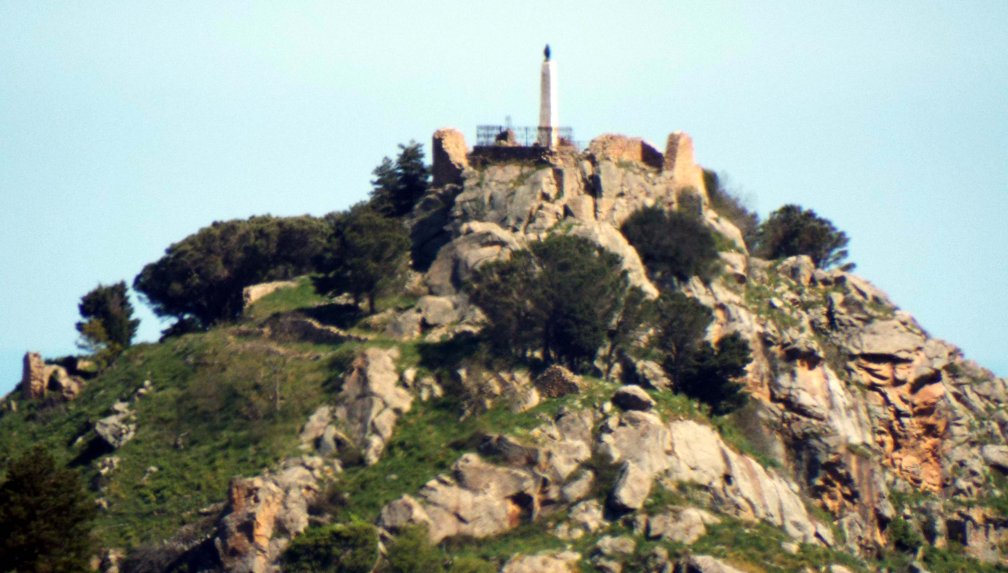Mistretta

In Roman times Mistretta was already regarded as most ancient - vetustissimo
- while excavation has uncovered Byzantine occupation levels.
Presumably the castle survived through the Arab occupation and by 1081
was a part of the diocese of Troina under Norman control. Two
years later in 1083, with the garrison of San Marco d'Alunzio castle, it revolted in favour of Jordan Hauteville (d.1091), the illegitmate son of Count Roger (d.1101). On Count Roger's
return from Italy the revolt fizzled out and the 12 ring leaders were
blinded, though Jordan was eventually pardoned. In 1101 it was
mentioned as a villa et castellum in Count Roger's domain. Twenty years later in 1122, it belonged to Matthew Bonellus and appeared in diplomas as either Creum or Amestratou. In 1131 Mistretta was transferred to the new diocese of Cefalu.
In 1160 both Caccamo and Mistretta took part in the successful rebellion of Matthew Bonellus against William I (d.1166). In February 1161 Matthew rode to his castle after having arranged for a further revolt in Palermo.
Once here he began to prepare the castle for attack and to restore the
apartments to hold the king prisoner in when he had captured him.
However, the plot was betrayed and on 9 March the prisoners in Palermo palace
revolted early, successfully seizing the king and his family.
Yet, 65 miles away from the action, Matthew could not influence events
and the plot misfired. By the time the discomforted plotters had
fled Palermo, he and his army had only reached Caccamo.
Mistretta and all the other castles of Bonellus were subsequently
seized by the Crown when Matthew was arrested and blinded on the revolt
of Butera castle
later that spring. At this point Mistretta castle reverted to the
royal domain. In 1254 the place rebelled against Peter Ruffo of
Messina (d.1256+).
After the fall and death of King Manfred of
Sicily in 1266, the new King Charles (d.1285) granted the castle to
Henry and Guglielmo Visconti, grandchildren of Pope Gregory X (1271-76)
in 1271. The grant possibly did not outlive the pope and the
castle was given to Peter Antioch before 1296 when he was holding it of
King Frederick III
(d.1337). Soon afterwards it was held by Blasco Alagona
(d.1301). Probably he was granted it when he was made count of
Mistretta. As his father only died in 1295, this was probably
within a few years of his death. His grandson Artal Alagona was
also count at the time of his death in 1389 and it is to be presumed
that they had control of the castle with the title during this
time.
In 1337 the fortress had been occupied by the rebels Enrico Rosso,
Frederick Chiaramonte (d.1363) and Frederick Ventimiglia. The
Alagona counts of Mistretta died out with the fourteenth century and in
1448 the fortress reverted to royal control. In 1450 it needed
urgent restoration work, but by 1458 was fully functional again, being
manned by a castellan and four sergeants. By 1520 the castle,
which was serving as a prison, was again in disrepair; the garrison
being reduced to the lord of the castle and the porter, with part of
their salary being directed towards repairs. These works would
seem to have been minor as by 1608 the castle was described as in
ruins. In 1633, following the seizing of the feudal lordship of
the Genoese lord of Mistretta, Gregorio Lancillotto Castelli, the
castle was attacked and demolished by the local population. In
1686 a large landslide destroyed the northeast slope of the fortress and no
doubt the ruins were then used as a quarry by the townsfolk.
Description
Today the castle is reached via a steep ramp that runs along the cliff
on which the castle stands at some 3,600'. This leads to a set back entrance
gate, with a large, blocked Romanesque gateway, which leads into a long
barbican down the west side of the main enceinte. This also
commands the entrance to the lower ward which surrounds the southern
half of the castle. The inner ward consists of a polygonal
enclosure encompassing the summit of the crag. There may have
been a keep to the southeast, but to the southwest was an irregular great hall of
which four ground floor lights still remain commanding the barbican
below to the west. The curtain wall to the east rests upon a
powerful stepped plinth of 3 orders, while two small rectangular towers
lay to the southwest near the church. Posterns lay to the southwest and southeast
beneath the keep area.
The ruins consist of the standard build rubble with higher quality
quoins at the corners. The main ward contains much more Roman
tile than the barbican and is therefore likely Byzantine in origin.
As such it fits quite easily into the class of other castles that
date to this era and are listed under Aci castle.
The barbican also sports long, narrow crossbow loops to the west which
again would suggest a Norman origin for this structure.
Archeological excavations in the 1980s found the foundations of a small
three-apsed church. It was thought to be Norman and set in a
layer of Byzantine material. According to a local source of 1902
the castle had four towers and a cistern.
There are remnants of the town wall, including a fine still inhabited
rectangular gatehouse with an impressively high Romanesque gateway.
Why not join me at other Sicilian
castles? Information on this and other tours can be found at Scholarly
Sojourns.
Copyright©2019
Paul Martin Remfry

